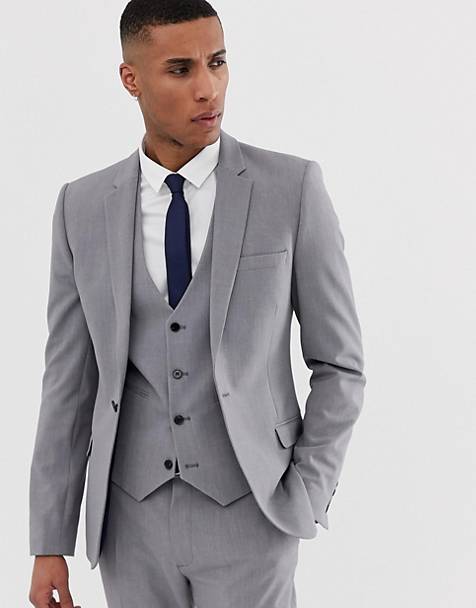Unfortunately, many of us don’t have the benefit of a seasoned fashion sense when it comes to choosing outfits. Picking out what to wear even for simple, everyday events can sometimes be tricky, while putting together a winning shirt, suit and tie combination for special occasions can be a major headache. See Step 1 below to get started!
Part 1: Picking a Shirt
- Generally, try to match your shirt and tie before you worry about your suit. While, in an ideal situation, all three items of clothing will match, it’s usually more important for your shirt and tie to match each other than it is for either to match your suit. Why? Because you can easily take your jacket off, while you’re stuck with whatever you choose to wear in terms of shirt and tie. So, if you have any say in the matter, try to prioritize your inner garments, rather than your suit.
- When in doubt, pick a neutral, solid-colored dress shirt. if you’re ever unsure of which dress shirt to pick when you’re putting together an outfit, you can’t go wrong by picking one that matches with everything such as “white”. When it comes to dress shirts, white, the most neutral color of all, is the easiest color to work with, as it goes with nearly all ties and suits.
- Other mild, pale shades of color, especially light blue, are also highly versatile and offer a variety of options when it comes to ties.
- For a bolder (but more difficult) look, choose a pastel or bold-colored shirt. Next in line after white and light-colored shirts are pastel shirts. These colors are fairly light, but not as neutral as colors like white and light blue – pastel shirts give the wearer a chance to pull off striking – or clashing – combinations. Finally, bold, richly-colored dress shirts offer truly unique possibilities. Paired with an appropriate tie, they can give the wearer a more sophisticated look, but can look showy or ridiculous when paired with inappropriate ties.
- Black shirts are the exception to this last point – they’re a dark, bold color, but, like white shirts, they’re very versatile and go with most types of ties.
- Pick a striped or patterned shirt for complex color interactions. Of course, not all dress shirts are a single, solid color. Many dress shirts are patterned with thin stripes (usually vertical but sometimes horizontal), while others bear dots, complex stitching, or other patterns. Generally, the larger and more complex a shirt’s pattern, the more attention-grabbing the shirt is, but the more difficult it is to match to a tie and suit.
- For most formal or semi-formal occasions, you’ll want to choose a shirt with a modest pattern. Thin vertical stripes of neutral colors (like white and light blue) are a safe bet, though small repeating patterns like dots are also fairly manageable (especially when at least one of the colors in the pattern are neutral ones).
- Shirts with more complex patterns, like intricate stitching across the chest, are sometimes best worn without ties, as the pattern and the tie can compete for attention.

Part 2: Matching a Tie to Your Shirt
- Pick a tie that’s darker than your shirt. Ties are attention grabbers. When paired with a complimentary shirt, a good tie will catch the eye of someone scanning a crowded room and direct his or her attention to your face. Accomplish this effect by choosing a tie that stands out against your shirt. Usually, this means picking a tie that’s a darker color than the shirt itself. For whites and other neutral colors, this means that almost any tie will work. However, for dark or bold-colored shirts, this can be more difficult.
- Picking a tie that’s lighter than your shirt is occasionally a viable option as long as it stands out against your shirt. For instance, if you’re wearing a black shirt, all ties except black ones will be brighter than your shirt, so you may want to pick a tie that strikes a bold contrast – for instance, a white one.

- For solid-color ties, pick a color that fits your purpose. Solid-color ties are fairly versatile – nearly any shade of solid-color tie looks good on a white shirt, while conservative shades like navy blue and black can look great on bolder-colored shirts. Generally, you’ll want to pick a solid-color tie that’s as eye-catching (or not) as your occasion warrants. A red tie on a white shirt, for instance, will create a striking (but not clashing) contrast that’s sure to get attention.
- Don’t pair a boldly-colored solid-color tie with a shirt that’s also boldly-colored unless you’re sure the combination works. Avoid extreme contrast – a cherry red tie and a bright green shirt, for instance, will be difficult to pull off.

- For patterned ties, pick a tie containing a color that’s similar to your shirt’s. If you opt for a patterned tie, a good way to ensure it matches your shirt is to ensure its pattern contains a color that’s the same (or nearly so) as the shirt’s somewhere in the pattern. In this case, assuming the colors within the tie’s pattern don’t clash with each other, your tie should match your shirt effortlessly.
- The exception to this rule is that you shouldn’t wear a tie with a small, repeating pattern whose background color is the same as the color of your shirt, as this creates little contrast.
- For example, if you’re wearing a light-blue shirt, you might choose a plaid tie featuring mostly Shades of dark blue and a small amount of light blue.
- Avoid picking ties with patterns that are the same as your shirt’s. Rule number one when it comes to matching ties and shirts is that like does not necessarily go with like. Patterned ties should not be paired with shirts with similar patterns. In these combinations, the interaction of the two patterns can create a bizarre, distracting effect not unlike that of an optical illusion. Additionally, a tie that’s patterned similarly to the shirt underneath is not likely to stand out against the shirt itself.
- For example, you won’t want to wear a plaid tie with a plaid shirt, a thin-striped tie with a thin-striped shirt, and so on.
Part 3: Matching a Suit to Your Shirt and Tie
- Opt for “serious”, formal colors. When it comes to suits, formal colors are your friends. Most people can’t pull off playful, brightly-colored suits. This isn’t to say that no one can – just that it takes tons of charisma and can make you look like a goofy game show host if it backfires. Most people are best-suited (no pun intend) to colors like black, grey, navy blue, and (sometimes) brown when it comes to formal pants and jackets.
- Not only are these colors more dignified (and thus a better choice for classy, formal events), but also easier to match with most shirts and ties.

- When in doubt, opt for dark, solid-color suits. As with shirts, when it comes to suits, simplicity equals versatility. Solid-color suits that are black, grey, or navy blue will work with most shirt and tie combinations. In addition, these suits are appropriate for a variety of occasions – from joyous events like weddings to somber ones like funerals. Most men should have at least one suit of these colors.
- Match a dark-colored suit with a neutral shirt and a dark-colored tie for a universally-dignified look. Brighter ties can work well with dark suits but can appear informal if too bright.
- Note that some sources claim that darker blues don’t pair well with black or navy blue suits

- Consider lighter solid-color suits for use with pastels and dark ties. Not every occasion requires a dark, formal suit. Tan, pale grey, lighter styles of tweed, and sometimes even white are possibilities when it comes to light-hearted or celebratory events. Try to pair these types of suits with pastels and/or dark ties for contrast.
- Avoid pairing a patterned suit with a similarly-patterned shirt or tie. As when dealing with patterned shirts and ties, it’s a wise idea to avoid pairing a patterned suit with any clothing containing a similar pattern. The most common suit pattern is pinstripes (very thin vertical stripes) so, usually, this means avoiding striped shirts or ties, especially if their stripes are vertical and thin.
- As a general rule, try to avoid wearing three patterned garments. In other words, make sure one of your garments is a solid color. It’s difficult to pull off three different patterns in the same outfit – if your look backfires, you may end up looking like a clown.
- Try to choose a suit that keeps the number of colors in your outfit to no more than three. Finally, you may want to pick a suit that doesn’t add any new colors if your outfit is already packed with color. Using your suit to add color to an outfit that has plenty is a bad idea – usually, the effect this produces is that of a muddled mess.
- To be clear, neutral shirt colors like white and similar shades of the same color on ties don’t count toward this “three color” rule. For example, if you’re wearing a dark blue plaid tie, the different shades of dark blue in the plaid pattern don’t count as separate colors.

From: Wikihow













